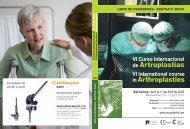cadera / hip - Active Congress.......
cadera / hip - Active Congress.......
cadera / hip - Active Congress.......
Create successful ePaper yourself
Turn your PDF publications into a flip-book with our unique Google optimized e-Paper software.
VIERNES / FRIDAY<br />
294<br />
DEALING WITH SEVERE<br />
FEMORAL BONE LOSS<br />
K. R. Berend MD,<br />
A. V. Lombardi, Jr., MD., FACS<br />
Joint Implant Surgeons, Inc.; the New<br />
Albany Surgical Hospital; New Albany,<br />
Ohio Departments of Orthopedics<br />
and Biomedical Engineering; the<br />
Ohio State University OH, USA<br />
As the population ages and as the longevity<br />
of total knee arthroplasty (TKA) increases,<br />
surgeons are faced with more and more<br />
complex reconstructive scenarios. Managing<br />
femoral bone loss in revision and complex<br />
primary TKA is one of these complex surgical<br />
problems. For many years, the orthopedic<br />
oncology world has dealt with distal femoral<br />
bone loss with the use of modular distal<br />
femoral replacement prostheses. Long-term<br />
concerns over fi xation, stress shielding, and<br />
bearing wear have plagued the successful<br />
tumor surgery. In revision TKA, the available<br />
bone stock, both in terms of quality<br />
and quantity, are signifi cantly affected. This<br />
makes successful fixation the first major<br />
issue. Options for reconstruction of distal<br />
femoral bone loss include allograft-prosthesis<br />
composite constructs and distal femoral<br />
replacements. Each option has its own set<br />
of benefi ts and drawbacks. Fixation options<br />
include the use of cemented stems, porous<br />
coated designs, and now newer compression<br />
loaded devices. Again, each alternative carries<br />
a certain risk versus benefi t that must be<br />
weighed by the surgeon. The current authors<br />
prefer the use of distal femoral replacement<br />
in these complex cases. Our experience with<br />
managing severe distal femoral bone loss in<br />
TKA is reviewed. The use of various fi xation<br />
modalities and newer novel alternatives are<br />
presented.<br />
THE ADVANTAGE<br />
OF CONSTRAINT IN<br />
REVISION SURGERY<br />
K. Steinbrink<br />
Evangelisches Krankenhaus Alsterdof<br />
Hamburg, Germany<br />
THE ROLE OF IMPLANT<br />
CONSTRAINT<br />
K. R. Berend MD,<br />
A. V. Lombardi, Jr., MD., FACS<br />
Joint Implant Surgeons, Inc.; the New<br />
Albany Surgical Hospital; New Albany,<br />
Ohio Departments of Orthopedics<br />
and Biomedical Engineering; the<br />
Ohio State University OH, USA<br />
As the degree of deformity, bone loss,<br />
contracture, ligamentous instability and<br />
osteopenia increases, so does the demand<br />
for prosthetic constraint. The workhorse in<br />
revision TKA is the posterior stabilized constrained<br />
(PSC) design. There is a continuum<br />
of constraint available that ranges from CR, to<br />
a CR lipped device, to an anterior stabilized<br />
device, to a posterior stabilized device, to a<br />
PS “plus” with varus-valgus constraint, to a<br />
PSC, to a rotating hinge. The senior author’s<br />
revision TKA experience includes 985 revision<br />
TKA performed from 1988 through 2005.<br />
A PSC device was used in 540 knees (55%),<br />
cruciate retaining in 49 (5%), posterior stabilized<br />
in 200 (20%), and rotating hinge in 195<br />
(20%). A single PSC design (Maxim; Biomet,





